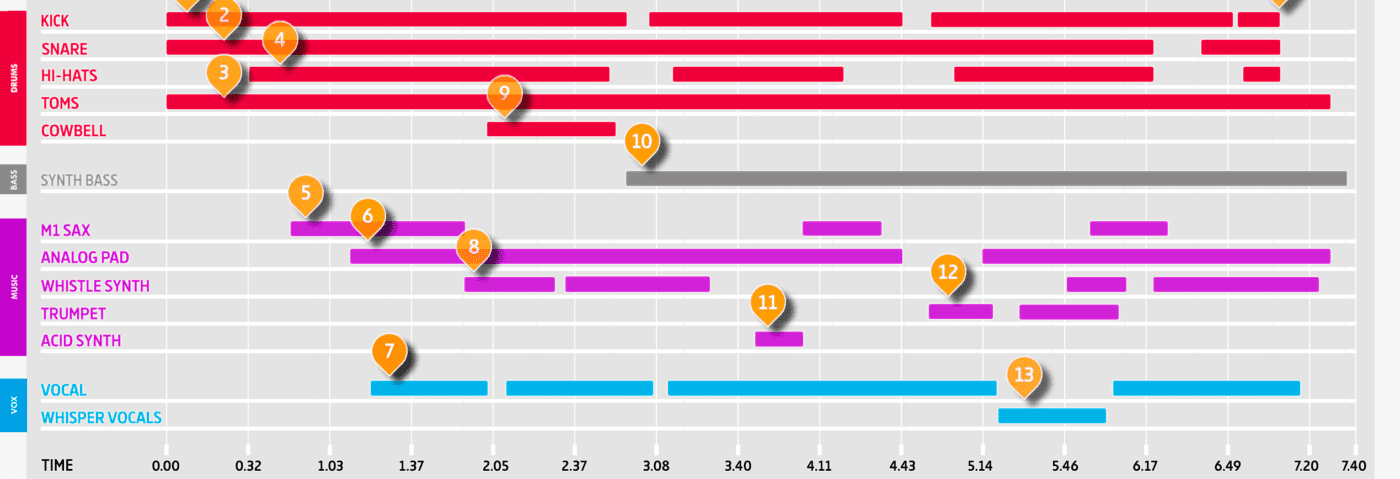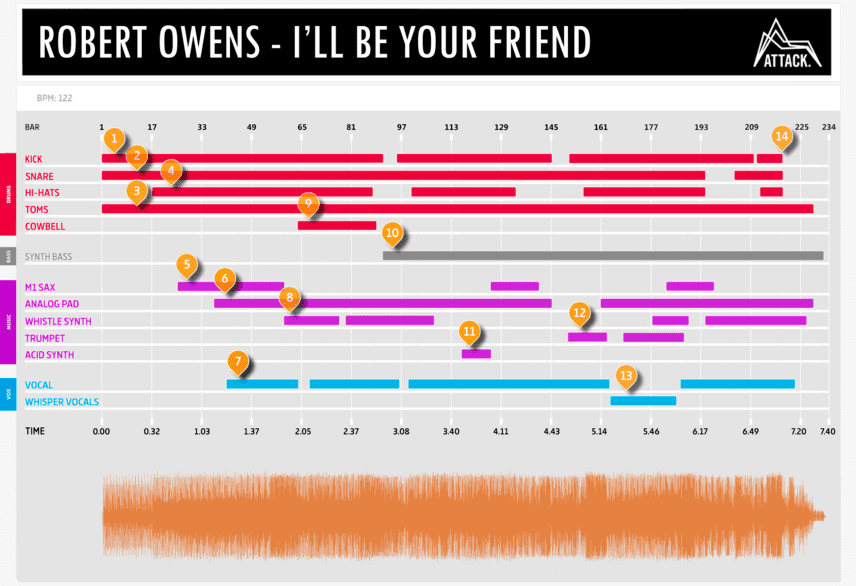In our Deconstructed series, we analyse the arrangements of tracks to see what we can learn from their structure. In this instalment, we’re setting the controls of the time machine to 1991 with a classic house cut – the original Def mix of Robert Owens’ club smash “I’ll Be Your Friend”.
Produced and mixed by the legendary David Morales and Satoshie Tomiie, this groovy slice of 90’s nostalgia is the epitome of its genre, to the point where it would be difficult to come up with a more perfect snapshot of the burgeoning house scene that was exploding at the time.
Tracks from this era are always interesting because the way they were made is so different to how technology permits us to make tunes with computers today. Rather than doing everything within a one-box DAW, an early 90’s setup consisted of a sequencer program like Notator running on a computer such as an Atari 1040ST, linked via MIDI to hardware synths, samplers and drum machines, all plugged into an analogue mixing desk and synced to timecode laid down on a track of a multitrack reel-to-reel tape machine. So let’s fire up the sonic DeLorean and take a journey back to early 90’s Chicago to find out exactly what makes this classic cut tick.
The Track
The Arrangement
What Happening?
- OK, so first of all, let’s talk kick drums. It wouldn’t be a house track without that solid four-four foundation, and true to form, ‘I’ll Be Your Friend’ relies on it heavily as the backbone of the rhythm track, hitting the ground running right from the off. Deep, round and satisfying without being too boomy, if David Morales was involved in the production the kick is almost certainly sourced directly from the audio output of a hardware machine like Roland’s TR-909. Clocking in at 121bpm, it lays down the foundation of the rhythm track, along with the snare part, which continue undisturbed for the first sixteen bars of the tune.
- The main snare sound in this track appears to have been sampled from the classic Amen break, a famous drum solo featured in The Winstons’ 1969 single ‘Amen, Brother’. This sample has been reused on countless recordings, and by the time ‘I’ll Be Your Friend’ was made in the early 90’s, samplers like Akai’s S1000 were well and truly established as the tools of the trade for your cutting-edge dance producer. This example has also been subjected to a generous splash of tape echo with a dotted eighth-note delay time and plenty of auto-panned repeats dialled in. At the time of production, well before the first software effects processors of the kind found in today’s DAWs, tempo-synced delays of this kind were only achievable by looking up the delay times on a chart of BPM and note values and entering the value in milliseconds into the front panel of your outboard delay processor.
- The lynchpin of the rhythm track, and also a main contributor to the musical fabric of the tune, is a kind of tribal-sounding, pitched sample that kicks in right from the start of the track. This sounds to us like a single upright bass note sampled and played back at three different pitches, which appear to be E, D, and G. It certainly has the characteristics of an early, low-resolution sample transposed down in pitch, as the noise and aliasing is more pronounced on the lower notes. As for the source of the original sample, we can only surmise that it might be from the bundled library that came with a hardware sampler, such as the aforementioned Akai S1000.
- The hi-hats, which come in at bar 17, are classic Roland TR-909 hats playing a classic 909 hat pattern – a ‘pea-soup’ open hat on the off-beat, surrounded by subtly-shuffling closed hats on the surrounding sixteenths. Just a hint of swing has been dialled in to drive the groove along and prevent things sounding too machine-y – the original 909 had a shuffle button for this very purpose. Just hold the button down, select a value with the larger note-entry buttons and voila! Instant groove.
- The second track-defining instrumental hook enters at bar 25. The sampled saxophone is actually a preset from Korg’s M1 Workstation synth, which dominated the synth market at the end of the 1980’s. At the time, the M1 sax (along with the genre-defining M1 piano sound) was as realistic as you could get, making it the go-to synthetic version of an instrument that was still very fashionable with pop and dance producers in its original form. A stabby, two-note line (playing the notes F and C in a sort of F5 power chord), the semitone pitch-bend on this particular part is also typical of attempts to make it sound more ‘real’ – the first note of each phrase starts a semitone below its target pitch and bends upwards to hit the desired pitch. It’s a bit of a surprise when the sax enters and establishes the tonal centre of the track as F, in direct conflict with the perceived notes played by the pitched sample bass/percussion part that’s been the only musical element we’ve heard thus far. It shouldn’t work – but it does!
- At bar 37, we’re joined by an ethereal-sounding analogue string pad part, played by what sounds like a Roland Juno-106 patch based on a triangle wave, with heaps of built-in chorus and a long release on the amplitude envelope, making the notes tail off slowly once the keys are released. The part centres around a long, sustained two-note F chord, playing root and fifth, just like the sax part.
- Bar 40 is the point at which we first hear that iconic vocal, as it fades gradually up from the depths with the first occurence of the “I’ll Be Your Friend, until the end…. of time” lyric. Soaked liberally in reverb and a similar bpm-synced delay effect to the one on the snare, the vocal is fairly freeform in nature, without a perceivable verse/chorus type structure, interspersing riffs and adlibs on the F minor scale with repeats of the main ‘I’ll Be Your Friend’ title hook. These repeats appear to have been sampled into a hardware sampler and retriggered via MIDI from whatever sequencer was used to construct the track, most likely an Atari 1040ST computer running either Cubase or Notator.
- Bar 59 marks the first appearance of a high-pitched, almost harmonica-esque analogue monophonic lead synth that plays a meandering line made up of long notes with lots of pitch bend. This part pops up a few times in the track, appearing again at bars 79, 177 and 193.
- At bar 63, a cowbell enters the rhythm track, playing on every third sixteenth note and swamped in dotted eighth-note delay to give the part a rolling groove. Oddly, the part only runs for 26 bars, disappearing again at bar 89 and staying out of the picture for the rest of the track.
- At bar 91, an interesting development occurs to reinforce the bottom end. The pitched sample that’s been taking care of the bass part up to this point is joined and beefed up by a proper synth bass sound playing a similar, complementary part that alternates between the notes F and Ab and endures right up to the end of the track.
- No track from 1991 would be complete without some sort of acid-house synth noise happening somewhere, and this tune obliges with a short eight-bar segment from bar 117-125. A little squelchy bass synth sound with loads of resonance on the filter and a suitable filter envelope shape to properly bring it out, pops up in these eight bars to play a riff around the notes C, Eb and F that complements the bass part perfectly. There’s some knob-twiddling involved as the filter cutoff and resonance values are adjusted slightly over the eight bars, then it disappears, having done its work, never to be seen again.
- Deep into the tune, at bar 150, we get a trumpet solo fading in gradually from the midst of a repeated “I’ll Be Your” triggered vocal sample. Given the prominently-featured M1 Sax preset, it’s safe to assume this is almost certainly the Trumpet (Preset 12) from the same synth. Expertly played (presumably by Satoshie Tomiie, credited as keyboard player on the track) and jamming fluently around the F minor blues scale, it drops out after 12 bars, to reappear for a longer solo from bars 168 to 187.
- At bar 164, the main vocal track is replaced by a whispered “Trust Me” vocal part that continues beneath the trumpet solo. The main vocal resumes once again at bar 185, coinciding with the end of the solo.
- The drums cease abruptly at bar 219, heralding the gradual breakdown that ends the song. Elements continue to drop out in order, starting with the vocal at bar 222 (as it cuts out mid-word, you can almost envision the mute buttons on the desk being hit as the mix runs off to DAT tape). The whistle synth bows out at bar 227, followed by the synth pad and sampled bass at bar 229, leaving only the synth bass running. This cuts out at bar 233, ending the tune, but not before someone (presumably Morales) turns up an effect send on the mixing desk, drenching the last bar of the part in reverb and delay as a final farewell.


03.42 PM
Stunning. I can hear every bit described. Takes me back.
06.15 AM
This was the best era of House music and even earlier from 1983 to 1991 NYC When The Paradise Garage was in full effect walking up that ramp past midnight and hearing Larry on his all night set of taking us all to another dimension in music like no other heard ever before.
God i wish we could turn back the hands of time and relive those moments….
Life was special like you can’t imagine.
Kimberly